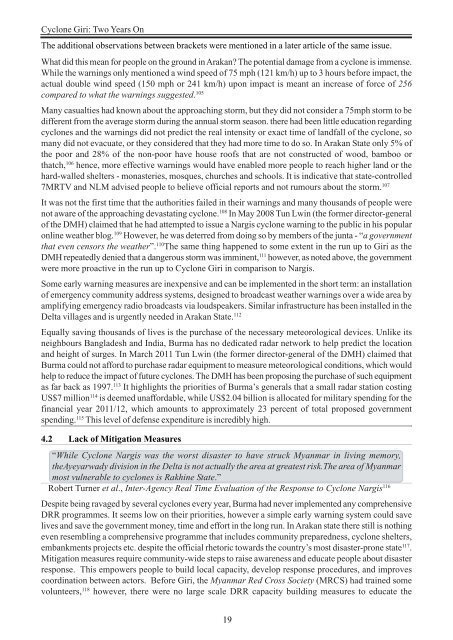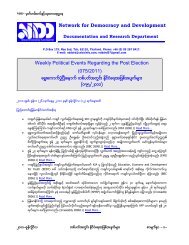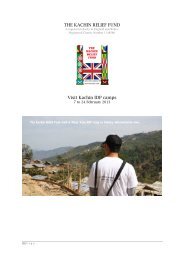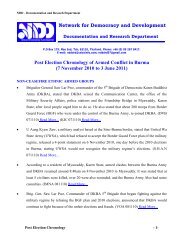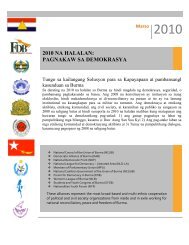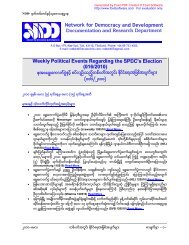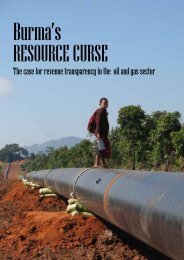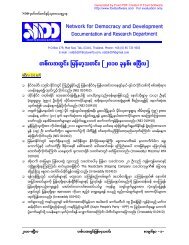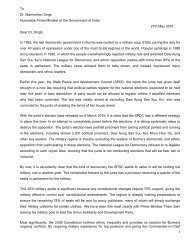Cyclone Giri - Two Years On - Burma Action Ireland
Cyclone Giri - Two Years On - Burma Action Ireland
Cyclone Giri - Two Years On - Burma Action Ireland
Create successful ePaper yourself
Turn your PDF publications into a flip-book with our unique Google optimized e-Paper software.
<strong>Cyclone</strong> <strong>Giri</strong>: <strong>Two</strong> <strong>Years</strong> <strong>On</strong><br />
The additional observations between brackets were mentioned in a later article of the same issue.<br />
What did this mean for people on the ground in Arakan The potential damage from a cyclone is immense.<br />
While the warnings only mentioned a wind speed of 75 mph (121 km/h) up to 3 hours before impact, the<br />
actual double wind speed (150 mph or 241 km/h) upon impact is meant an increase of force of 256<br />
compared to what the warnings suggested. 105<br />
Many casualties had known about the approaching storm, but they did not consider a 75mph storm to be<br />
different from the average storm during the annual storm season. there had been little education regarding<br />
cyclones and the warnings did not predict the real intensity or exact time of landfall of the cyclone, so<br />
many did not evacuate, or they considered that they had more time to do so. In Arakan State only 5% of<br />
the poor and 28% of the non-poor have house roofs that are not constructed of wood, bamboo or<br />
thatch, 106 hence, more effective warnings would have enabled more people to reach higher land or the<br />
hard-walled shelters - monasteries, mosques, churches and schools. It is indicative that state-controlled<br />
7MRTV and NLM advised people to believe official reports and not rumours about the storm. 107<br />
It was not the first time that the authorities failed in their warnings and many thousands of people were<br />
not aware of the approaching devastating cyclone. 108 In May 2008 Tun Lwin (the former director-general<br />
of the DMH) claimed that he had attempted to issue a Nargis cyclone warning to the public in his popular<br />
online weather blog. 109 However, he was deterred from doing so by members of the junta - “a government<br />
that even censors the weather”. 110 The same thing happened to some extent in the run up to <strong>Giri</strong> as the<br />
DMH repeatedly denied that a dangerous storm was imminent, 111 however, as noted above, the government<br />
were more proactive in the run up to <strong>Cyclone</strong> <strong>Giri</strong> in comparison to Nargis.<br />
Some early warning measures are inexpensive and can be implemented in the short term: an installation<br />
of emergency community address systems, designed to broadcast weather warnings over a wide area by<br />
amplifying emergency radio broadcasts via loudspeakers. Similar infrastructure has been installed in the<br />
Delta villages and is urgently needed in Arakan State. 112<br />
Equally saving thousands of lives is the purchase of the necessary meteorological devices. Unlike its<br />
neighbours Bangladesh and India, <strong>Burma</strong> has no dedicated radar network to help predict the location<br />
and height of surges. In March 2011 Tun Lwin (the former director-general of the DMH) claimed that<br />
<strong>Burma</strong> could not afford to purchase radar equipment to measure meteorological conditions, which would<br />
help to reduce the impact of future cyclones. The DMH has been proposing the purchase of such equipment<br />
as far back as 1997. 113 It highlights the priorities of <strong>Burma</strong>’s generals that a small radar station costing<br />
US$7 million 114 is deemed unaffordable, while US$2.04 billion is allocated for military spending for the<br />
financial year 2011/12, which amounts to approximately 23 percent of total proposed government<br />
spending. 115 This level of defense expenditure is incredibly high.<br />
4.2 Lack of Mitigation Measures<br />
“While <strong>Cyclone</strong> Nargis was the worst disaster to have struck Myanmar in living memory,<br />
theAyeyarwady division in the Delta is not actually the area at greatest risk.The area of Myanmar<br />
most vulnerable to cyclones is Rakhine State.”<br />
Robert Turner et al., Inter-Agency Real Time Evaluation of the Response to <strong>Cyclone</strong> Nargis 116<br />
Despite being ravaged by several cyclones every year, <strong>Burma</strong> had never implemented any comprehensive<br />
DRR programmes. It seems low on their priorities, however a simple early warning system could save<br />
lives and save the government money, time and effort in the long run. In Arakan state there still is nothing<br />
even resembling a comprehensive programme that includes community preparedness, cyclone shelters,<br />
embankments projects etc. despite the official rhetoric towards the country’s most disaster-prone state 117 .<br />
Mitigation measures require community-wide steps to raise awareness and educate people about disaster<br />
response. This empowers people to build local capacity, develop response procedures, and improves<br />
coordination between actors. Before <strong>Giri</strong>, the Myanmar Red Cross Society (MRCS) had trained some<br />
volunteers, 118 however, there were no large scale DRR capacity building measures to educate the<br />
19


